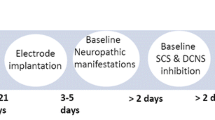Summary
-
1.
The effect of making discrete lesions in the cervical spinal cord on the brainstem elicited inhibition of a spinal somato-sympathetic reflex response has been studied in anaesthetized cats.
-
2.
Electrical stimulation within three areas of the medulla caused an inhibition of the spinal component of the reflex response elicited in thoracic white rami communicantes by stimulation of intercostal nerves. The three medullary areas studied were the ventrolateral medulla and the caudal raphe nucleus, from where bulbospinal monoamine neurones originate, and the ventromedial reticular formation.
-
3.
The inhibitory effects of stimulation in the ventrolateral medulla and raphe nucleus were abolished by the destruction of part of the ipsilateral dorsolateral funiculus of the cervical spinal cord, whereas the inhibition produced by ventromedical reticular formation stimulation was abolished by lesions which included part of the ventral quadrant of the cord.
-
4.
The time course of the inhibitory effects of electrical stimulation of descending sympatho-inhibitory tracts in the cervical spinal cord was studied in unanaesthetized decerebrate cats spinalized at C1. Inhibition obtained from the dorsolateral funiculus characteristically had a longer time to onset than inhibition obtained from the ventrolateral and ventral funiculi.
Similar content being viewed by others
References
Alexander, R. S.: Tonic and reflex functions of medullary sympathetic cardiovascular centres. J. Neurophysiol.9, 205–217 (1946)
Beacham, W. S., Perl, E. R.: Characteristics of a spinal sympathetic reflex. J. Physiol. (Lond.)173, 431–448 (1964)
Brodal, A.: Neurological anatomy in relation to clinical medicine. 2nd Ed., p. 325. Oxford: University Press 1969
Carlsson, A., Falck, B., Fuxe, K., Hillarp, N.-A.: Cellular localization of monoamines in the spinal cord. Acta physiol. scand.60, 112–119 (1964)
Coote, J. H., Downman, C. B. B.: Supraspinal control of reflex activity in renal nerves. J. Physiol. (Lond.)202, 161–170 (1969)
Coote, J. H., Downman., C. B. B., Weber, W. V.: Reflex discharges into thoracic white rami elicited by somatic and visceral afferent excitation. J. Physiol. (Lond.)207, 147–158 (1969)
Coote, J. H., Macleod, V. H.: The possibility that noradrenaline is a sympatho-inhibitory transmitter in the spinal cord. J. Physiol. (Lond.)225, 44–46 P (1972)
Coote, J. H., Macleod, V. H.: The influence of bulbospinal monoaminergic pathways on sympathetic nerve activity. J. Physiol. (Lond.)241, 453–475 (1974a)
Coote, J. H., Macleod, V. H.: Evidence for the involvement in the baroreceptor reflex of a descending, inhibitory pathway. J. Physiol. (Lond.)241, 477–496 (1974b)
Dahlstrom, A., Fuxe, K.: Evidence for the existence of monoamine neurons in the central nervous system. II. Experimentally induced changes in intraneuronal amine levels of bulbospinal neuron systems. Acta physiol. scand.62, Suppl. 247, 5–36 (1965)
Eh, S., Huan-Ji, D.: The descending pathways of the bulbar cardiovascular centre. Acta physiol. sinica27, 108–114 (1964)
Gootman, P. M., Cohen, M. I.: Evoked splanchnic potentials produced by electrical stimulation of medullary vasomotor regions. Exp. Brain Res.13, 1–14 (1971)
Illert, M., Gabriel, M.: Mapping the cord of the spinal cat for sympathetic and blood pressure responses Brain Res.23, 274–276 (1970)
Illert, M., Gabriel, M.: Descending pathways in, the cervical cord of cats affecting blood pressure and sympathetic activity. Pflügers Arch.335, 109–124 (1972)
Illert, M., Seller, H.: A descending sympatho-inhibitory tract in the ventrolateral column of the cat. Pflügers Arch.313, 343–360 (1969)
Kahn, N., Mills, E.: Centrally evoked sympathetic discharge: a functional study of medullary vasomotor areas. J. Physiol. (Lond.)191, 339–352 (1967)
Kirchner, F., Sato, A., Weidinger, H.: Bulbar inhibition of spinal and supraspinal sympathetic reflex discharges. Pflügers Arch.326, 324–333 (1971)
Kluver, H., Barrera, E.: A method for the combined staining of cells and fibres in the nervous system. J. Neuropath. exp. Neurol.12, 400–403 (1953)
Konishi, M.: Fluorescence microscopy of the spinal cord of the dog, with special reference to the autonomic lateral horn cells. Arch. histol. jap.30, 33–44 (1968)
Prout, B. J., Coote, J. H., Downman, C. B. B.: Supraspinal inhibition of a cutaneous vascular reflex in the cat. Amer. J. Physiol.207, 303–307 (1964)
Scherrer, H.: Inhibition of sympathetic discharge by stimulation of the medulla oblongata in the rat. Acta neuroveg. (Wien)29, 56–74 (1966)
Wang, G. H., Brown, V. W.: Suprasegmental inhibition of an autonomic reflex. J. Neurophysiol.19, 564–572 (1956)
Author information
Authors and Affiliations
Rights and permissions
About this article
Cite this article
Coote, J.H., Macleod, V.H. The spinal route of sympatho-inhibitory pathways descending from the medulla oblongata. Pflugers Arch. 359, 335–347 (1975). https://doi.org/10.1007/BF00581444
Received:
Issue Date:
DOI: https://doi.org/10.1007/BF00581444




